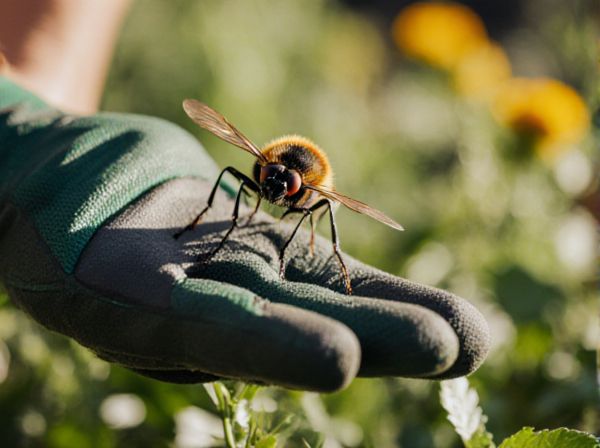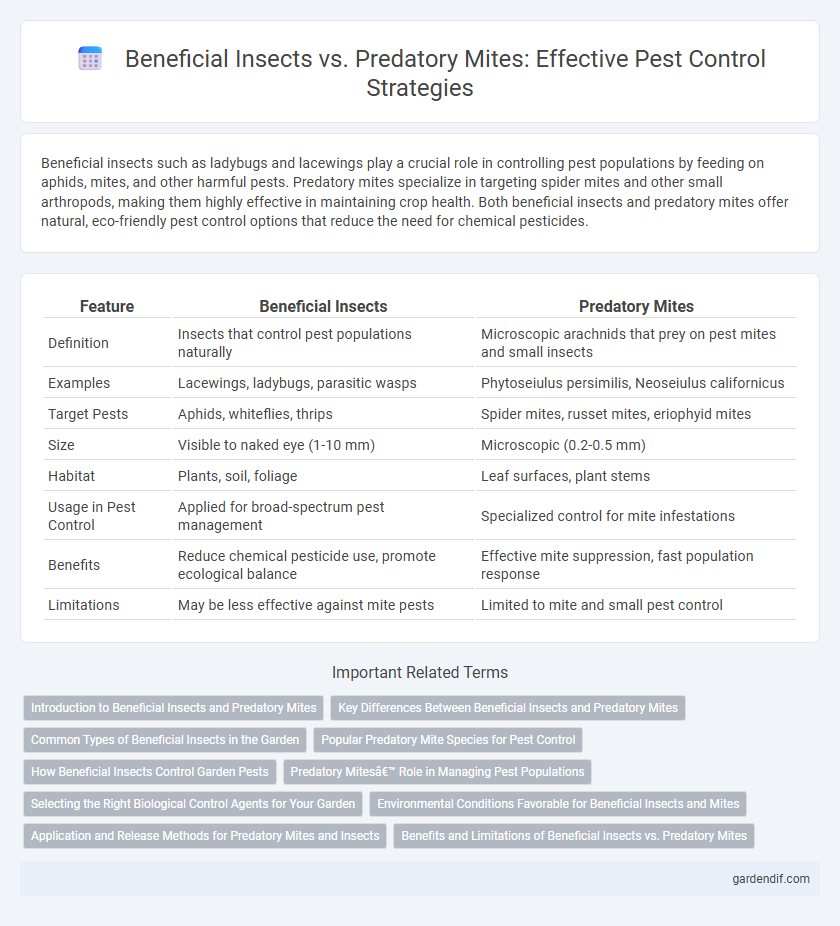
Beneficial insects vs Predatory mites Illustration
Beneficial insects such as ladybugs and lacewings play a crucial role in controlling pest populations by feeding on aphids, mites, and other harmful pests. Predatory mites specialize in targeting spider mites and other small arthropods, making them highly effective in maintaining crop health. Both beneficial insects and predatory mites offer natural, eco-friendly pest control options that reduce the need for chemical pesticides.
Table of Comparison
| Feature | Beneficial Insects | Predatory Mites |
|---|---|---|
| Definition | Insects that control pest populations naturally | Microscopic arachnids that prey on pest mites and small insects |
| Examples | Lacewings, ladybugs, parasitic wasps | Phytoseiulus persimilis, Neoseiulus californicus |
| Target Pests | Aphids, whiteflies, thrips | Spider mites, russet mites, eriophyid mites |
| Size | Visible to naked eye (1-10 mm) | Microscopic (0.2-0.5 mm) |
| Habitat | Plants, soil, foliage | Leaf surfaces, plant stems |
| Usage in Pest Control | Applied for broad-spectrum pest management | Specialized control for mite infestations |
| Benefits | Reduce chemical pesticide use, promote ecological balance | Effective mite suppression, fast population response |
| Limitations | May be less effective against mite pests | Limited to mite and small pest control |
Introduction to Beneficial Insects and Predatory Mites
Beneficial insects and predatory mites are vital components in integrated pest management, naturally controlling harmful pest populations without chemical interventions. Beneficial insects, such as lady beetles and lacewings, actively prey on aphids, whiteflies, and thrips, while predatory mites specifically target spider mites and small insect eggs. Utilizing these natural predators promotes sustainable agriculture by reducing pesticide reliance and maintaining ecological balance in crop environments.
Key Differences Between Beneficial Insects and Predatory Mites
Beneficial insects, such as ladybugs and lacewings, primarily consume a wide range of pest insects, providing broad-spectrum pest control, whereas predatory mites specifically target small pest mites and thrips, offering precise management of mite populations. Beneficial insects are generally larger, more mobile, and can cover extensive areas, while predatory mites are microscopic, requiring close habitat conditions to be effective. The reproductive cycles and environmental tolerances of predatory mites also differ significantly from beneficial insects, influencing their use in integrated pest management strategies.
Common Types of Beneficial Insects in the Garden
Beneficial insects such as ladybugs, lacewings, and parasitic wasps play a crucial role in natural pest control by feeding on aphids, scale insects, and whiteflies. Predatory mites, including Phytoseiulus persimilis and Neoseiulus californicus, target spider mites and other small pests affecting plants. Integrating these biological control agents enhances garden health by reducing reliance on chemical pesticides and promoting ecosystem balance.
Popular Predatory Mite Species for Pest Control
Popular predatory mite species for pest control include Phytoseiulus persimilis, Neoseiulus californicus, and Amblyseius swirskii, known for their effectiveness against spider mites and thrips. These mites target harmful pests by feeding on their eggs and larvae, reducing pest populations naturally without harming beneficial insects like pollinators. Integrating predatory mites into pest management programs enhances sustainable agriculture by minimizing chemical pesticide use and promoting ecological balance.
How Beneficial Insects Control Garden Pests
Beneficial insects such as ladybugs, lacewings, and parasitic wasps play a crucial role in controlling garden pests by directly preying on aphids, whiteflies, and caterpillars, reducing pest populations naturally. These insects contribute to an integrated pest management system by minimizing the need for chemical pesticides and promoting ecological balance. Predatory mites, while effective against spider mites and small insects, complement beneficial insects, offering a targeted approach to pest regulation in diverse garden environments.
Predatory Mites’ Role in Managing Pest Populations
Predatory mites play a crucial role in managing pest populations by targeting harmful insects such as spider mites and thrips, effectively reducing crop damage. Their ability to thrive in various environmental conditions and rapidly reproduce makes them a sustainable and efficient biological control agent in integrated pest management (IPM) programs. Utilizing predatory mites minimizes the need for chemical pesticides, promoting eco-friendly and balanced pest control in agricultural and horticultural practices.
Selecting the Right Biological Control Agents for Your Garden
Beneficial insects like ladybugs and lacewings effectively target aphids and other soft-bodied pests, promoting a balanced garden ecosystem. Predatory mites specialize in controlling spider mites and small arthropods, offering precise pest management for vulnerable plants. Selecting the appropriate biological control agents depends on identifying the specific pest species and understanding their lifecycle to ensure optimal garden health.
Environmental Conditions Favorable for Beneficial Insects and Mites
Beneficial insects such as ladybugs and lacewings thrive in environments with moderate humidity and diverse vegetation, which provide ample food sources and shelter for reproduction. Predatory mites prefer warm temperatures between 20-30degC and low humidity levels below 70%, conditions that optimize their mobility and feeding efficiency on pest mites. Maintaining balanced microclimates with natural plant diversity supports the coexistence and effectiveness of both beneficial insects and predatory mites in integrated pest management.
Application and Release Methods for Predatory Mites and Insects
Predatory mites are commonly applied through slow-release sachets or direct spraying to ensure even distribution and sustained pest control in crops, whereas beneficial insects like ladybugs or lacewings are typically released manually or via automated dispensers for immediate pest predation. Predatory mites require high humidity and specific microclimate conditions for optimal establishment, often necessitating frequent, smaller releases to maintain effective populations, while beneficial insects may be released in larger numbers less frequently due to their mobility and wider environmental tolerance. Precise timing aligned with pest life cycles enhances efficacy for both methods, with predatory mite applications focusing on early infestation stages and beneficial insect releases targeting peak pest populations.
Benefits and Limitations of Beneficial Insects vs. Predatory Mites
Beneficial insects such as ladybugs and lacewings offer broad pest control by targeting multiple pest species, but their effectiveness can be hindered by environmental conditions and slower reproductive rates. Predatory mites provide rapid, focused control of specific pests like spider mites, thriving in microhabitats where they reproduce quickly, yet their narrow prey range limits their overall pest management scope. Combining both beneficial insects and predatory mites enhances integrated pest management by balancing broad-spectrum control with targeted suppression, although careful monitoring is required to optimize their complementary roles.
Beneficial insects vs Predatory mites Infographic

 gardendif.com
gardendif.com